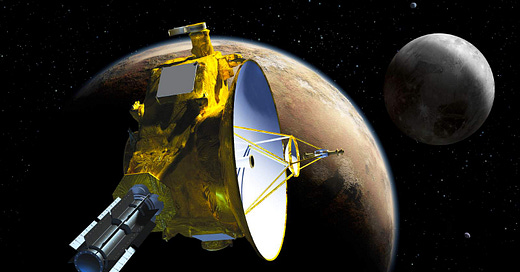Taxpayers and Astronauts
EDITOR’S NOTE: This post originally appeared at The Roots of Liberty December 2015.
Just under a decade ago, an Atlas V rocket lifted off from Cape Canaveral and sent a thousand pound spacecraft name New Horizons on a very, very, VERY long journey. With a little help from Jupiter's gravity, New Horizons arrived at the distant ex-planet Pluto this past summer. How distant? About 3 billion miles. That's REALLY far away. It's so far away that signals traveling to Earth (at the speed of light, of course) take nearly four and a half hours to arrive.
Well, "arrived at" is a bit inaccurate. It whizzed by Pluto at 31,000 miles per hour, snapping photographs and collecting scientific data before, during and after this fly-by. New Horizons will spend months sending data back, then will travel on to an object in the Kuiper Belt, a region of space that starts at about Neptune's orbit and extends well beyond.
The total cost for the New Horizons mission is pegged at about $700 million. That's a lot of money, and the purist libertarian in me doesn't believe that governments have the right to spend taxpayer money in such fashion. Purist libertarianism is nice for armchair discussions and theory development, but reining in a government that spent $3.5 trillion last year doesn't start with purism. $700 million over a decade is $70 million a year, and the government loses that much every 6 hours to Medicare waste and fraud.
Lets contrast this with another space exploration endeavor: the International Space Station (ISS). ISS is fundamentally different from New Horizons and other robotic probes in that it involves putting people in space. Man-in-space is the stuff that captures our imagination. Stories of man-in-space span back a century and a half, to Jules Verne's From the Earth to the Moon. Edgar Rice Burroughs envisioned the planet Mars filled with different races a century ago. The 1950s brought us Altair-4 (the Forbidden Planet) and a visit from Klaatu and Gort in The Day The Earth Stood Still. The sixties gave us Star Trek, the seventies Star Wars, and man-in-space entertainment exploded after that. Tens of thousands of science fiction books have been written, and a large percentage of them involves man-in-space in some form.
It's no surprise, then, that man-in-space is what fills our minds with wonder and excitement, entertains us and sells movies and books. That entertainment is science fiction, with an emphasis on fiction. The hard realities of man-in-space are waved away in favor of exciting stories. This entertains and sells, which is great. It also suggests that "we," usually meaning NASA, should be working towards putting man in space, which is not so great.
The ISS, the first piece of which launched 17 years ago, has cost $150 billion to date. That's over 200 times the cost of the New Horizons mission. Has it done more "science" than New Horizons? Certainly, but a huge part of that cost is about simply keeping the astronauts alive. Man-in-space comes with all sorts of requirements not necessary for robotic probes, requirements that include:
- Habitat (living space)
- Temperature Regulation
- Waste Heat Disposal
- Air
- Air Purification
- Water
- Water Purification
- Food
- Body Waste Management
- Clothing
- Laundry
- Personal Hygiene
- Radiation Protection
- Medicine
- Medical Equipment
- Windows
Building a system that can provide all this costs a lot of money. Every pound of mass that has to be lifted off the Earth's surface and put into space costs money. Putting things into low orbit is expensive. Moving them to higher orbit or sending it to the Moon is even more expensive. Pushing them to, say, Mars, is yet more expensive. Everything that has to come back just piles on more costs.
Back in the early 1990s, the government started a program it called the Space Exploration Initiative, which included a permanent space station orbiting the Earth, permanent stations on the Moon ,and sending astronauts to Mars. Total cost was projected at $500 billion over 20-30 years. Lets double that for today's dollars and as a nod to reality. That's a trillion dollars to put people on Mars and bring them home. If our goal is a sense of wonder and achievement, it's hard to peg a "fair" price. But, if our goal is science, we really should ask ourselves what the opportunity cost of that trillion dollars is, and how much of that cost is "wasted" merely to keep the astronauts alive. For that trillion dollars, NASA could perform 1400 New Horizons-type exploration missions. For that trillion dollars, NASA could send hundreds of robotic probes to Mars, and return a whole lot more science than one trip with astronauts ever could.
That trillion dollars will have to come from somewhere. That somewhere is taxation, borrowing, printing presses, or a combination of all three. Taxation takes money out of the private sector, subtracting the productivity it would foster. Borrowing saddles future generations with interest payments, leaching wealth out of the economy. Printing presses devalue everyone's wealth.
To what end?
Science? The numbers show man-in-space is a terribly inefficient means of doing space and planetary science.
Pride? That's a big part of the reason we sent men to the Moon in the 1960s. America won the "space race," then promptly lost interest. The Apollo program, originally scheduled to have 10 lunar landing missions, was terminated after 7. To learn a bit about pride, we can fast-forward the movie Pulp Fiction to about 23:15 and listen to what Marcellus Wallace had to say about pride. That aside, there isn't much pride to be derived from massive bureaucracy and spending run-amok, both hallmarks of our government today, and both certain to be hallmarks of any government-funded mission to Mars.
Inspiration? Back in the early days of Mercury, Gemini and Apollo, sure. Many were inspired to jobs in science and engineering. Today, though, man-in-space is positively pedestrian. Who pays attention to the ISS, anyway? Sure, a Mars mission would be deeply exciting for many, but do we really need to spend a trillion dollars we don't have to excite people who would as easily and far more cheaply be excited by movies and by the goings-on in the private sector?
In an era where science and technology are at the fore, where young people are connected to the Internet almost from birth, where technology is ubiquitous, where "nerd culture" has become mainstream, where billionaires like Elon Musk and Jeff Bezos are investing in private space travel, and where government spending and national debt have grown to record levels, it's harder and harder to justify massive, expensive, budget-busting dreams of taxpayer-funded man-in-space. Those massive, expensive, budget-busting dreams crowd out more pedestrian but far more productive science missions that don't involve man-in-space. Man-in-space will happen in the private sector, that is a certainty. It's time taxpayers are no longer asked to pay for it.
If you enjoy The Roots of Liberty, please subscribe (if you have already, thank you!), and please recommend the blog to your friends! While I share it as much as I can on social media, subscribing ensures you won't miss a post.
If you really like The Roots of Liberty and want to help keep it rolling, please consider becoming a paying subscriber here at Substack, or at a lighter level as contributor to the blog via Patreon.
Thank you for your support!
Yours in liberty,
Peter.





